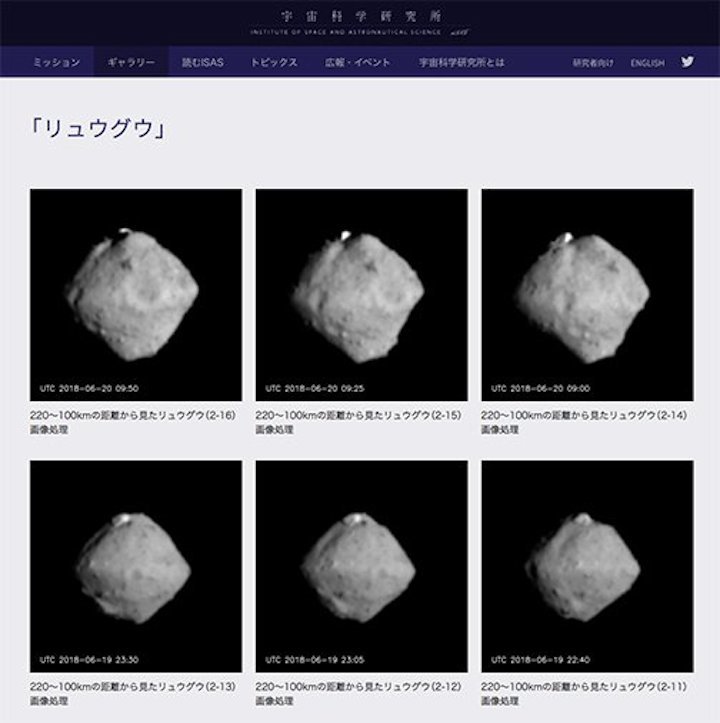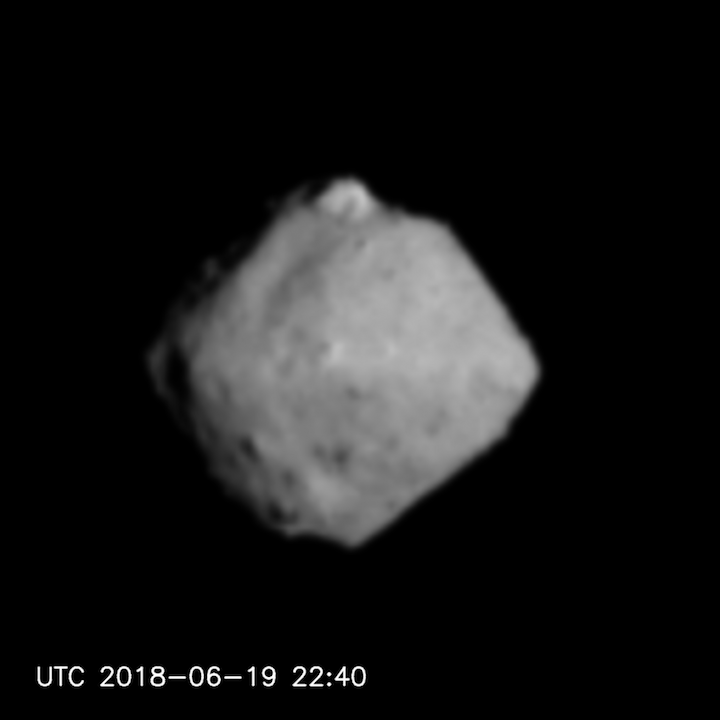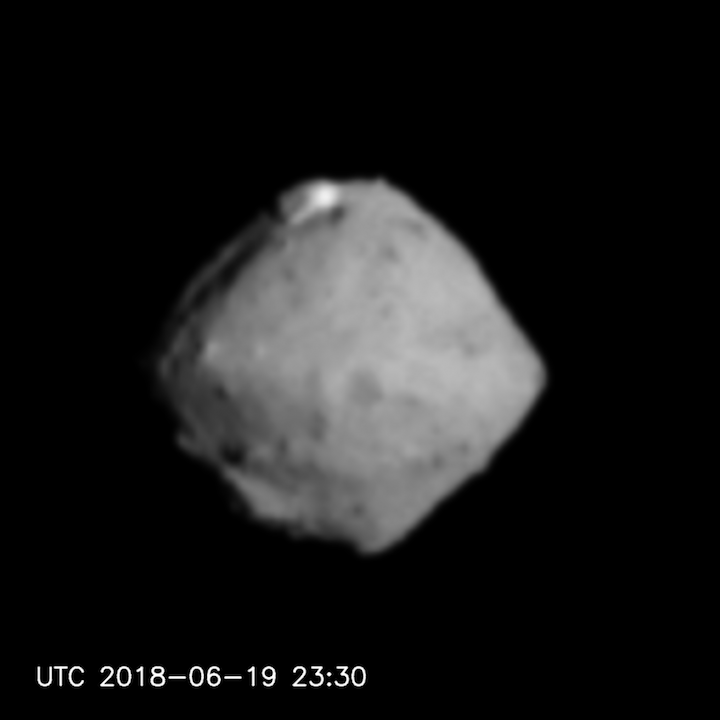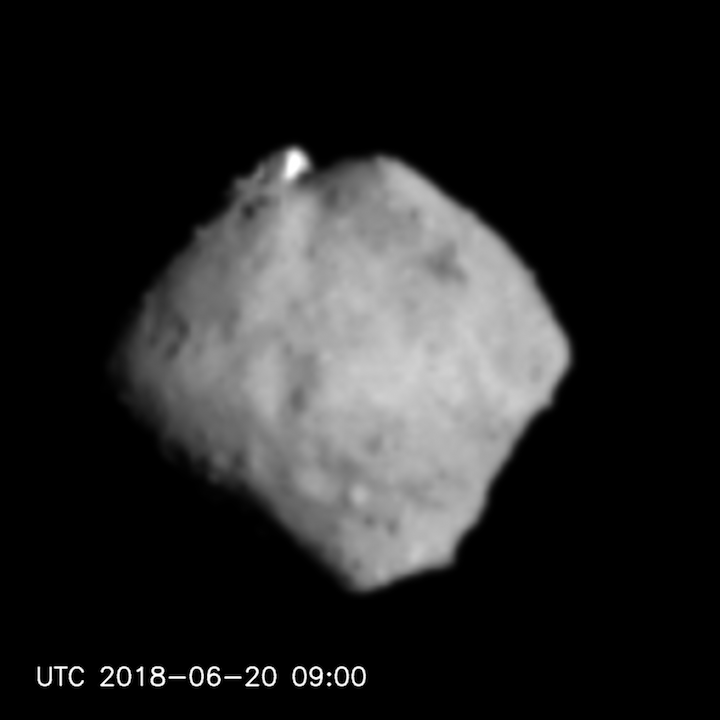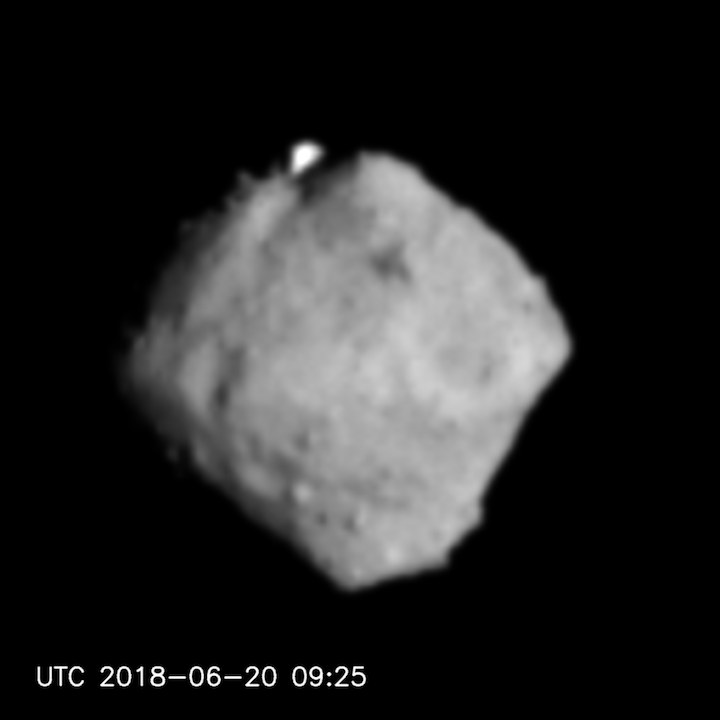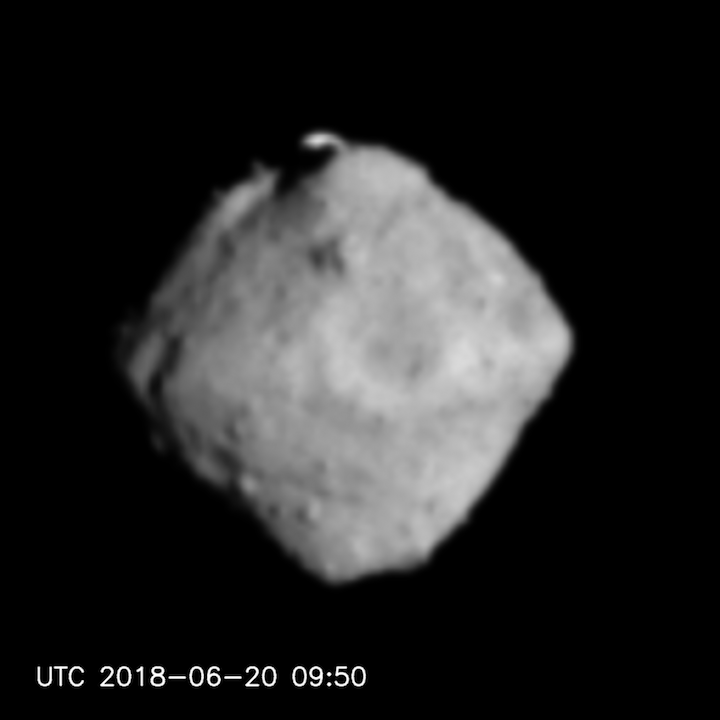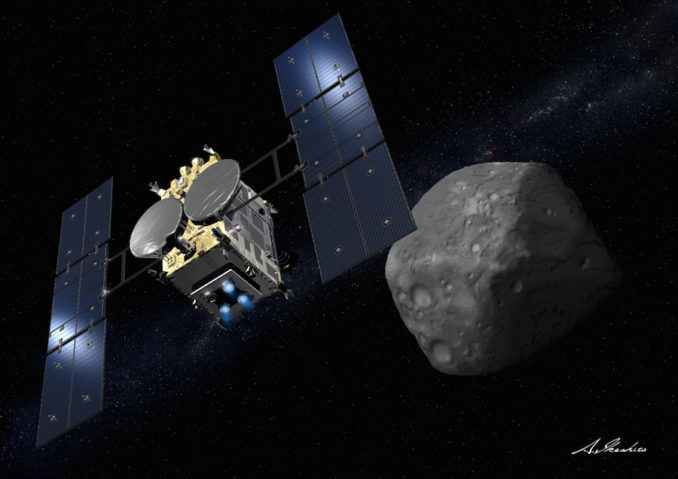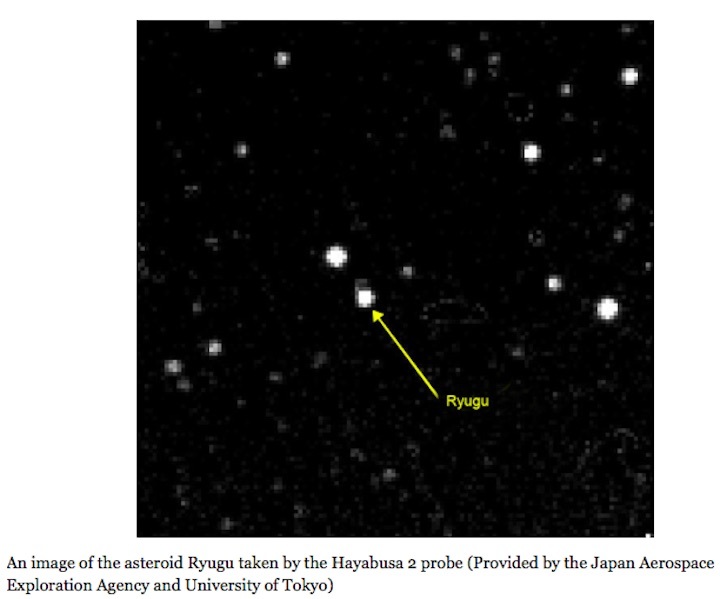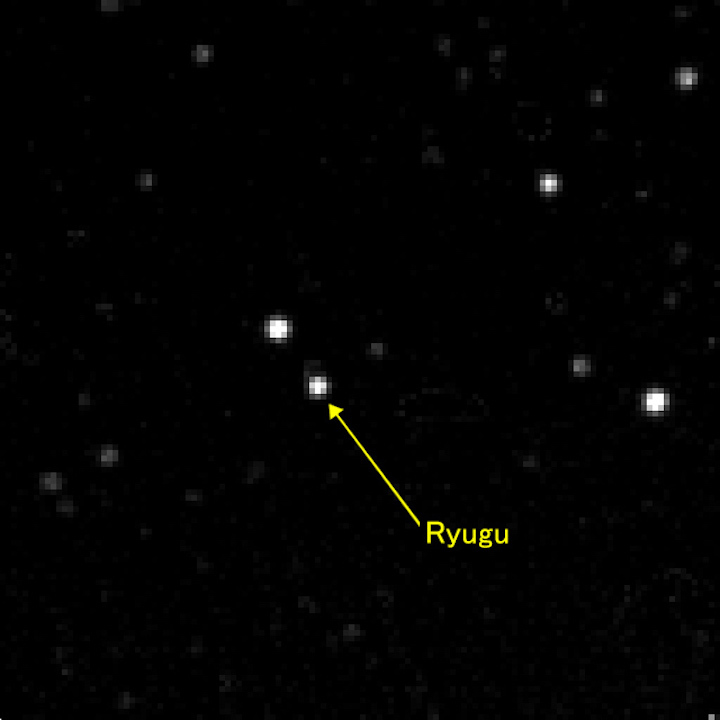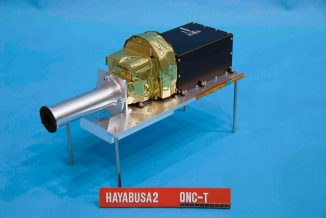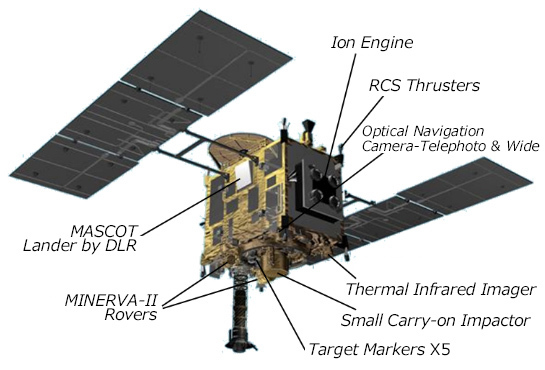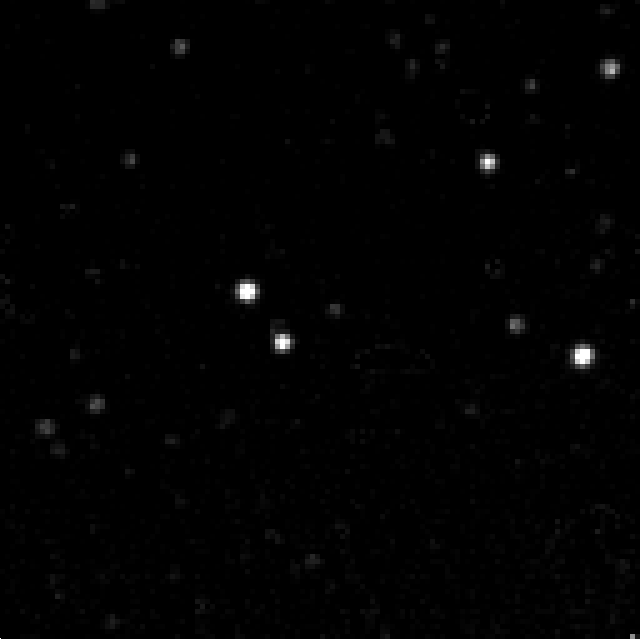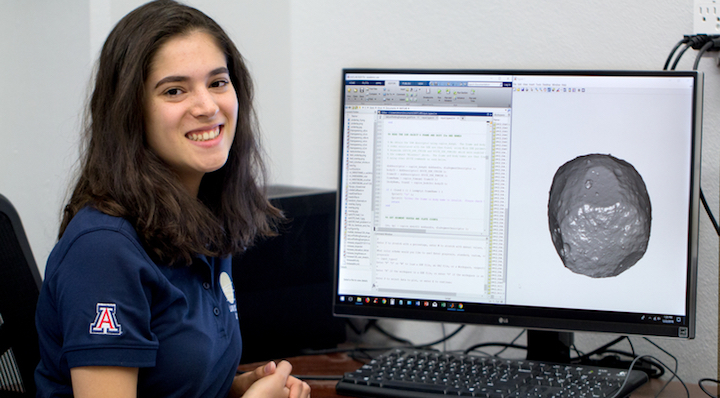
Adriana Mitchell, an undergraduate in the University of Arizona's College of Optical Sciences and Honors College who has been working with assistant professor Vishnu Reddy at the Lunar and Planetary Laboratory, is this year's sole UA recipient of the Barry M. Goldwater Scholarship and Excellence in Education. And soon she will be on her way to Japan for a unique opportunity.
The Goldwater Scholarship Program, one of the oldest and most prestigious national scholarships in the natural sciences, engineering and mathematics, seeks to identify and support college sophomores and juniors who show exceptional promise in the aforementioned fields. The scholarship provides a maximum of $7,500 per year to the student for educational expenses.
Mitchell has big plans for her future, and the Goldwater Scholarship could help those dreams come true.
"My professional aspiration is to manage NASA research missions to worlds with astrobiological implications," she says. "To reach my goal, I must first obtain a Ph.D. and learn the inner workings of interplanetary spacecraft missions."
This summer, Mitchell will travel to Japan to work with the Japan Aerospace Exploration Agency, or JAXA, on the Hayabusa2 project, a sample return mission to asteroid Ryugu. Hayabusa2 is the sister project to the UA-led OSIRIS-REx mission by NASA.
Mitchell will be at JAXA headquarters during the approach and arrival phases of the mission, assisting with the creation of digital terrain models, which she says is "a direct application of my current research on asteroids at the University of Arizona." Lucille Le Corre, a NASA-funded co-investigator on the Hayabusa2 mission, will mentor Mitchell.
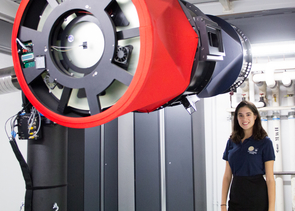
"It is a privilege to work with talented undergraduate students like Adriana," says assistant professor Vishnu Reddy, Mitchell's mentor at the UA.
-
The opportunity was supported and encouraged by Reddy, who is Mitchell's mentor at the UA.
"She had been working with me for a year as a NASA Space Grant intern and she wanted to do something different for her study abroad, working on a real spacecraft mission," says Reddy, who worked to organize the collaboration with Le Corre. "I'm very proud of her, and she's always been a go-getter. It is a privilege to work with talented undergraduate students like Adriana."
Mitchell, who will leave for Japan on June 27, says, "This would not be possible without the Goldwater Foundation's support and opportunities provided by my mentors here."
Mitchell previously worked with Matt Penn at the National Solar Observatory on a research project, "Polar Plume Dynamics of the Indonesian 2016 Total Solar Eclipse," to determine the true speed of solar winds. The project was presented by Mitchell at two conferences, including the 2017 Graduate and Professional Student Council Student Showcase and the 229th meeting of the American Astronomical Society.
She also has published in journals and presented at other conferences in her growing research career. She has presented research at the Crossroads Eclipse 2017 Research Workshop, the 2017 Eclipse Science Showcase and the 12th American Physical Society Conference for Undergraduate Women in Physics.
Quelle: University of Arizona
---
Update: 15.06.2018
.
JAXA releases images of Ryugu taken by Hayabusa-2
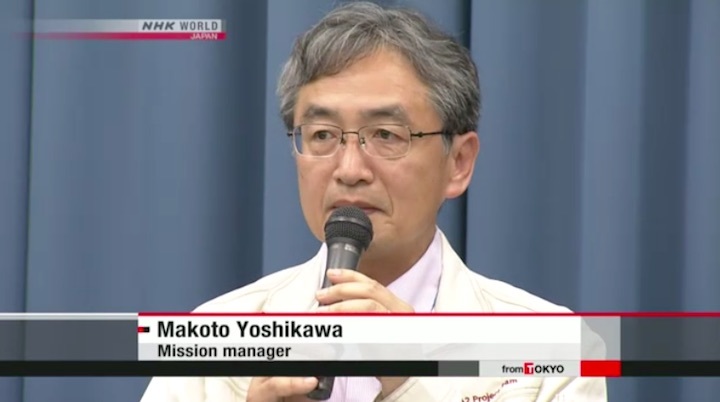
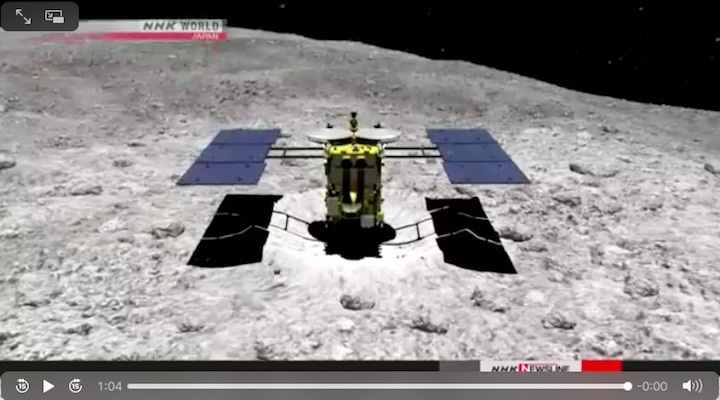
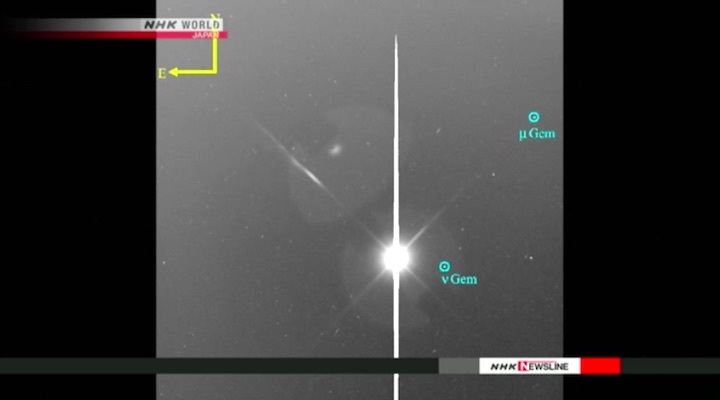

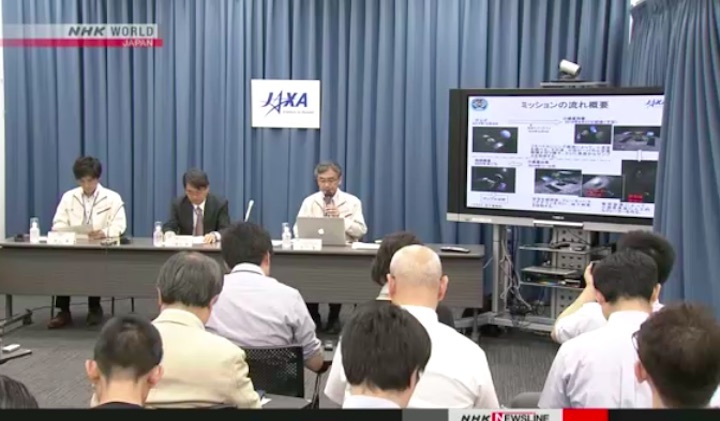
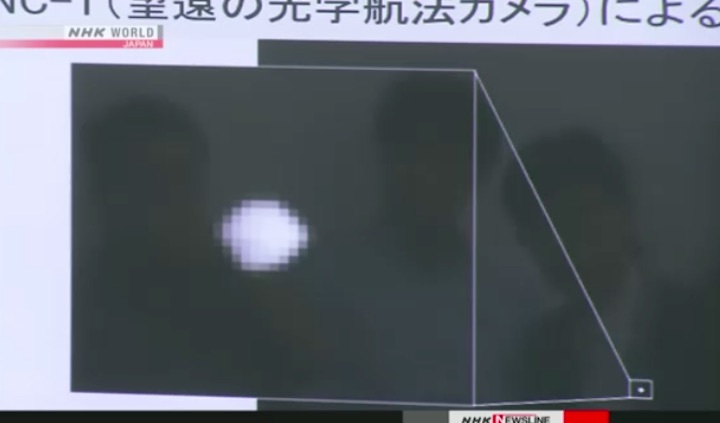
The Japan Aerospace Exploration Agency, or JAXA, has released new images of the Ryugu asteroid taken by its probe Hayabusa-2.
JAXA said on Thursday that the probe is about 800 kilometers from the asteroid, 4 years after being launched.
The images were taken on Wednesday, 920 kilometers from the asteroid.
JAXA said they show that Ryugu is generally round, although it looks partly angular. It added that they also show it is 900 meters in diameter and has a rotation period of 7 hours and 40 minutes.
The Hayabusa-2 was launched from the Tanegashima Space Center in Japan's southern prefecture of Kagoshima. The probe is now about 300 million kilometers from Earth.
The craft is expected to reach 20 kilometers from the asteroid around June 27th and enter its orbit to closely observe its surface and shape.
The probe's prime mission is to land on Ryugu and collect samples from its surface.
Scientists hope the mission will shed more light on the origins of life if water or organic matter is found in the samples.
JAXA mission manager Makoto Yoshikawa says he expects clearer images of Ryugu next week when the probe gets closer to the asteroid.
Quelle: NHK World
+++
Hayabusa 2 captures newest image of Ryugu asteroid
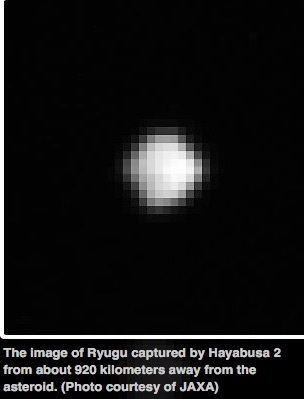
The Japan Aerospace Exploration Agency (JAXA) revealed the latest image of asteroid Ryugu captured by its explorer Hayabusa 2 on June 14. The Hayabusa 2 is scheduled to come within roughly 20 kilometers from the asteroid around June 27.
The image was taken on June 13 from approximately 920 kilometers from Ryugu. The asteroid appears to be roundish with some rugged features. It is estimated to be about 1 kilometer in diameter.
Hayabusa 2 was about 700 kilometers from Ryugu as of June 14, and is approaching the asteroid at a speed of about 1.7 meters per second. Makoto Yoshikawa, JAXA associate professor and the mission manager of the Hayabusa 2 project, said, "The shape and size (of the asteroid) is about the same as our estimates. We are really looking forward to watching it up close."
(Japanese original by Tomohiro Ikeda, Science & Environment News Departmet)
Sample return mission Hayabusa2 approaching Asteroid Ryugu
The Japanese asteroid sampling mission Hayabusa2, launched on December 3, 2014 aboard an H-IIA rocket from Tanegashima, Japan, has nearly completed its long flight to asteroid Ryugu (formerly 1999 JU3) after a five year mission and an Earth flyby.
The mission was approved as a follow-on to the Hayabusa mission which became the first probe to sample an asteroid when it landed on the young “rubble pile” asteroid Itokawa, though the mission had its share of problems.
The Hayabusa mission to Itokawa had problems with one of its four ion engines from the start of the mission after a solar flare damaged the craft and two reaction wheels failed before its approach to Itokawa.
The hopper that was supposed to land on the surface missed the asteroid and flew off into deep space, the sampling mechanism did not function properly, and although Hayabusa was able to land on Itokawa, it suffered thruster leaks and another ion engine failed during the trip home, and contact was lost for several weeks after the second landing on Itokawa, delaying Hayabusa’s departure to Earth.
(Japanese Tribute video for Hayabusa)
Despite this, 1,500 microscopic samples from Itokawa were successfully returned and examined after the capsule landed in the Woomera test range in Australia in 2010.
The Hayabusa2 follow-on has one more reaction wheel (to make four) and improved, higher thrust ion engines, along with a backup asteroid sampling system, and the spacecraft is in good health so far.
Hayabusa2 is a 600 kilogram (1300 pound) spacecraft that is based on the Hayabusa craft, with some improvements.
It is powered by two solar panels and uses an ion engine with xenon propellant as its main propulsion source. The ion engine technology was first used in the Deep Space One experimental spacecraft in the late 1990’s and also has been successfully used in the Dawn asteroid probe as well.
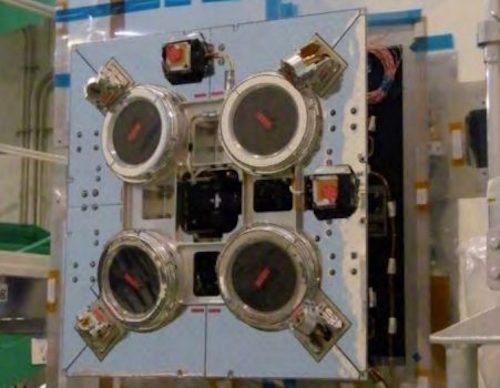
Although the thrust is very low it is continuous and can be used to propel a spacecraft to very high velocities over time, very efficiently.
The craft also features thrusters and four reaction wheels to maintain its position in space as well as four auxiliary lander/hopper craft, a sub-satellite, and an impactor, along with sampling mechanisms, a full suite of science instruments and a reentry capsule to return samples to Earth.
The Hayabusa2 mission is intended to image and sample the asteroid 1999 JU3, discovered in May 1999, now known as Ryugu, and to return samples of the asteroid, including samples excavated from an impactor to collect materials from under the surface, to Earth for analysis in laboratories.
Besides the primary and backup sample collectors, the mission includes three MINERVA “hoppers” similar to the one used on the original Hayabusa mission that will land at several locations on the surface to study these locations with cameras and thermometers.
An impactor (SCI) with a 2 kg pure copper lump (Liner) will be used to excavate a crater on the surface, and there will be a sub-satellite that will be released to observe the impact.
he main imaging instrument is the ONC (Optical Navigation Camera) which has telephoto and wide-angle modes, and which is being used right now to provide optical images of Ryugu, which are being used to navigate Hayabusa2 safely to the asteroid. Once at Ryugu, this instrument will image the surface.
Other instruments that will be used are the TIR (Thermal Infrared Camera) which will measure the asteroid’s surface temperature, the NIRS3 (Near Infrared Spectrometer) which will check the distribution of minerals on the surface using the 3 micron band, and the laser altimeter (LIDAR) which measures the distance between the spacecraft and the asteroid.
International contributions include a small robotic lander (10 kilograms or 20 pounds) called MASCOT that is a joint venture of DLR (Germany) and CNES (France), while NASA is providing communications through the Deep Space Network.
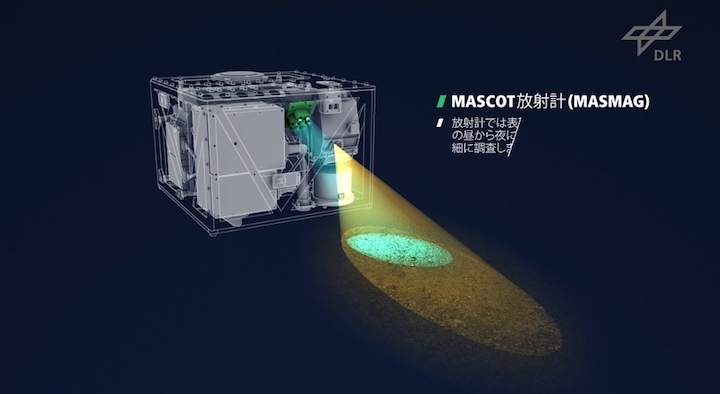
MASCOT’s purpose is to provide extremely detailed mineralogical and geological surveys of the asteroid’s surface, providing up to 16 hours of data with a battery set to last 2 asteroidal days, and will use four instruments (MicrOmega – a hyperspectral microscope, MAG – a magnetometer, CAM – a camera, and MARA – a radiometer) to do this.
MASCOT will “jump” to various sites on the surface using a robotic arm to study these sites in detail, after being released from Hayabusa2 100 meters (328 feet) above the surface of the asteroid. MASCOT systems are based on designs from Rosetta/Philae, Phobos-Grunt, and ExoMars.
The Hayabusa2 craft has finished its first correction burn and is now less than 600 kilometers (372 miles) away from asteroid Ryugu. Over the coming days the asteroid, which is now seen as a small round object, will become much more visible and surface features will be seen.
The craft is also searching for any satellites that may be orbiting the asteroid, and have not detected any so far (detection limit: larger than 50 cm). Other asteroids such as Ida have been found to have satellites, and satellites can be hazards to navigation for spacecraft like Hayabusa2.
Ryugu itself is approximately 880 meters wide (nearly a kilometer), rotates around its axis every 7 hours 38 minutes, and is thought to be very dark (0.05 albedo). Ryugu orbits from a distance just within Earth’s orbit to as far as just outside Mars’ orbit around the Sun, and its orbital radius around the Sun is 180 million kilometers (111 million miles), orbiting the Sun in 1.3 Earth years.
It is believed that Ryugu is an older C-type asteroid that may have material from the beginning of the solar system (including water and organics), or at least more ancient material, as opposed to Itokawa, an S-type asteroid. Ryugu appears to be mostly spherical, unlike Itokawa’s potato shape, and we are seeing the asteroid in more detail as the spacecraft draws closer.
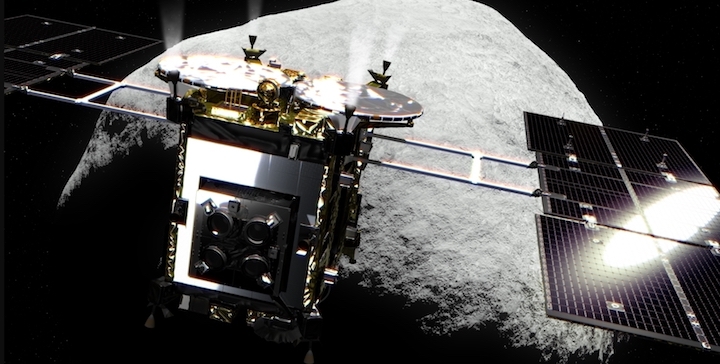
Its arrival at Ryugu is set for June 27th, and Hayabusa2 will be 20 km (12 miles) above the surface on that date, as things currently stand. The arrival will be followed by a press conference in Sagamihara, Japan.
After arrival, Hayabusa2 will start imaging the asteroid, with medium altitude observations at 5 km (3 miles) starting at the end of July. In August, Hayabusa2 is set to measure the asteroid’s gravity by going to an altitude of 1 km (0.6 miles) above the surface, and in the fall (September – October timeframe) the first touchdown and MINERVA deployment are set to occur.
After solar conjunction in late fall (November – December) where communication will not be possible with the probe, Hayabusa2 will resume contact afterward and conduct more medium altitude observations at 5 km to start 2019, with the second touchdown in February and the artificial crater experiment using the impactor in the spring (March – April timeframe).
The third touchdown on the asteroid will follow in April or May, and another MINERVA deployment will follow in July. The Hayabusa2 craft will remain near Ryugu until the end of 2019 (November or December) when it will depart for Earth after 18 months at Ryugu. The sample delivery reentry capsule is set to be returned to Earth in late 2020.
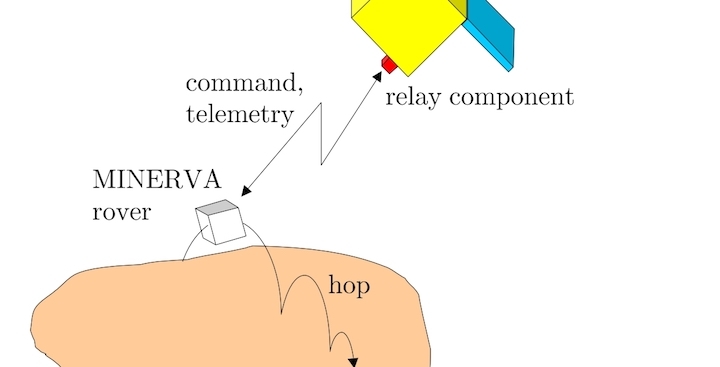
Asteroids are remnants of the building blocks of the solar system and can tell us important details about how the solar system, and by extension Earth and ourselves, came to be, and asteroids can and have endangered life on this planet throughout geologic history. Most notably, a 10 kilometer (6 mile) wide asteroid hit the area of the Yucatán in Mexico 65 million years ago and ended the reign of the dinosaurs.
A future asteroid could pose a similar threat to humanity and Ryugu is classified as one of these “potentially hazardous asteroids” (PHAs) in the Apollo group.
What we learn about these asteroids will inform how we intercept one if the time ever came. Finally, asteroids are being looked at as potential sites for mining metals for future industries, and the composition of asteroids like Ryugu will inform mining plans as well.
For all these reasons, missions like Hayabusa2, Osiris-Rex (to approach Bennu in 2 months), and others are very important efforts to understand the solar system.
Quelle: NS
---
Update: 18.06.2018
.
Hayabusa2 and MASCOT lander nearing Ryugu

Hayabusa2, JAXA's asteroid explorer, and the MASCOT lander, developed by the German Aerospace Center (DLR) and the French space agency (CNES) have been travelling through space since December 2013.
They are finally closing in on their destination asteroid – Ryugu. As of 14 June 2018, the distance between Hayabusa2 and Ryugu is less than 770 kilometres and the closing speed is 2.1 metres per second.
On 13 June 2018, the 'Optical Navigation Camera – Telescopic' (ONC T) acquired an image of Ryugu, where the asteroid extends to 10 pixels. The short exposure time means that the background star field is invisible.
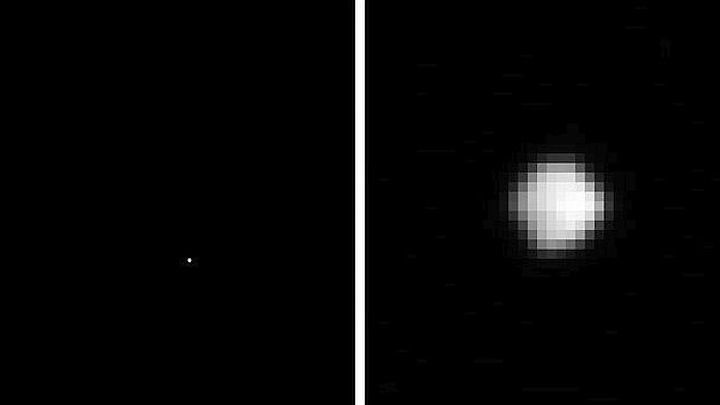
Earlier, the ONC-T also acquired an image with a much longer exposure time in which the background stars are visible.
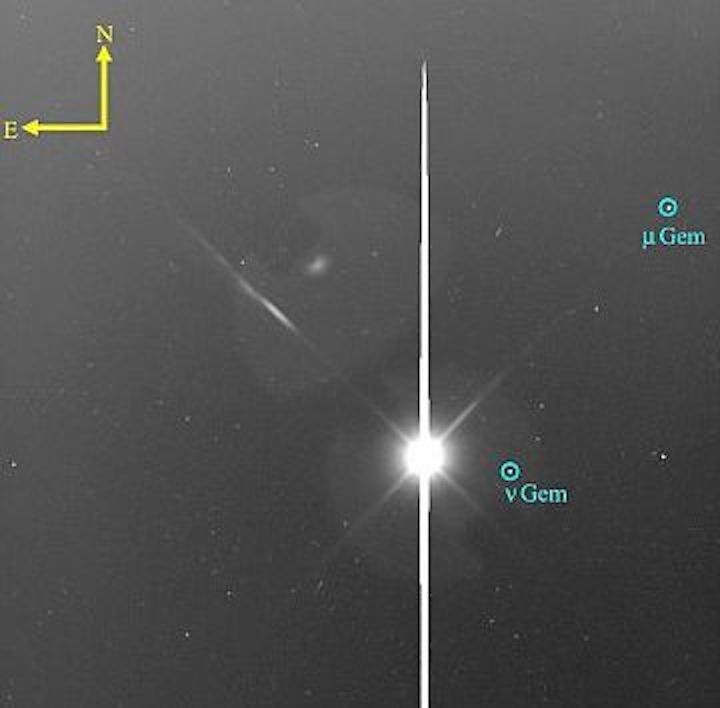
mage of Ryugu acquired by the ONC T on board Hayabusa2 at around 12:50 JST (05:50 CEST, 03:50 UTC) on 10 June 2018. The distance to the asteroid is approximately 1500 kilometres and the field of view is 6.5 × 6.5 degrees; the exposure time was 178 seconds. Ryugu, which is visible against the constellation Gemini, is sufficiently bright that it has partially saturated the ONC T sensor. Copyright: See note at the end of this post.
Quelle: DLR
---
Update: 19.06.2018 / 12.00 MESZ
.
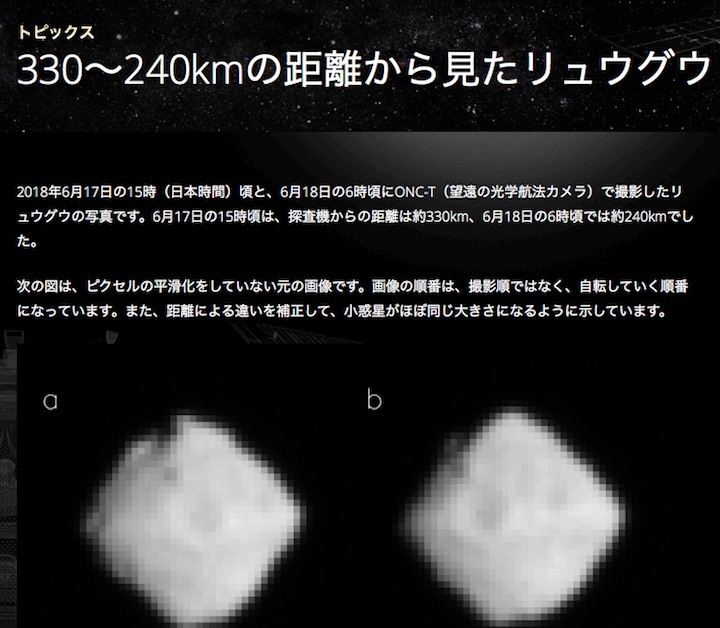
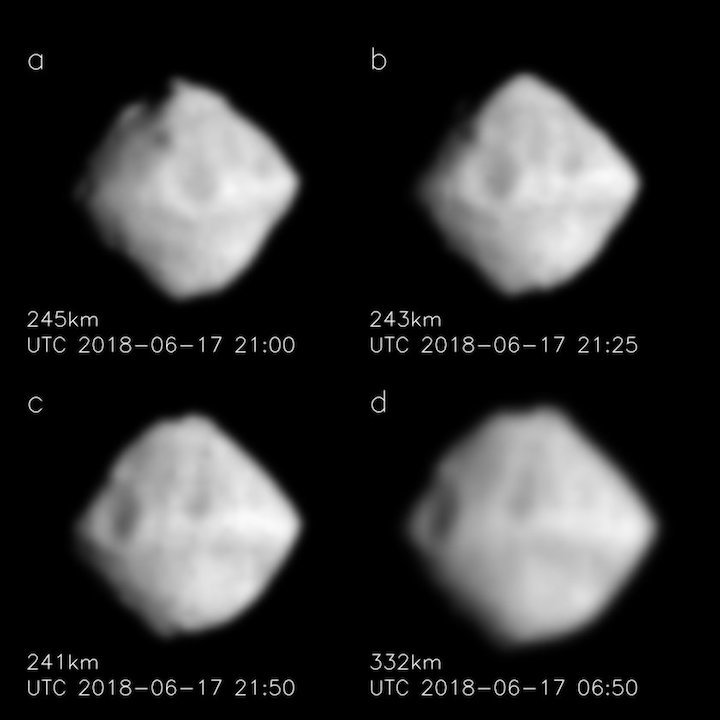
Quelle: JAXA
-
+++ 19.00 MESZ
.
Dumpling-shaped' space rock comes into view
A Japanese spacecraft is sending back images as it approaches an irregularly shaped asteroid that some on the mission have compared to a dumpling.
The Hayabusa 2 spacecraft was launched in 2014 on a quest to study the asteroid Ryugu and deliver rocks and soil from its surface to Earth.
The craft is now about 215km away from Ryugu and should arrive on 27 June.
Hayabusa's camera is starting to resolve its shape, which has been likened to a Japanese dango dumpling.
But closer inspection shows that the object is pitted with dents or craters.
In addition, the asteroid's orbit is retrograde, meaning that it spins in the opposite direction to the Sun and the Earth.
The video shown above was compiled from 52 images captured by the spacecraft's ONC-T camera (Optical Navigation Camera - Telescopic) between 14 and 15 June.
Around 27 June, the spacecraft will arrive at a distance of 20km from the asteroid, which goes by the formal name of 162173 Ryugu.
The Japanese Aerospace Exploration Agency (Jaxa) spacecraft will then survey the object for a year-and-a-half, during which it will aim to deploy several landing craft on the surface and use an explosive device to dig out a "fresh" rocky sample from within Ryugu.
Some of the landing craft could be deployed as early as September; they include a German-made instrument package called Mascot (Mobile Asteroid Surface Scout).
The mission will depart Ryugu in December 2019 with the intention of returning to Earth with the asteroid samples in 2020.
The first Hayabusa spacecraft was launched in 2003 and reached the asteroid Itokawa in 2005. It was also designed to deliver asteroid samples to Earth but was hit by a series of mishaps.
For example, the attempt to recover soil from Itokawa suffered from communication problems, leading to initial confusion over whether the probe had actually touched down.
But the spacecraft eventually returned to Earth in 2010 with a small amount of material from the asteroid.
An American asteroid sample return mission, Osiris-Rex, will rendezvous with the asteroid 101955 Bennu in August.
Quelle: BBC
---
Update: 21.06.2018
.
New photos show 'spinning top' shape of asteroid Ryugu
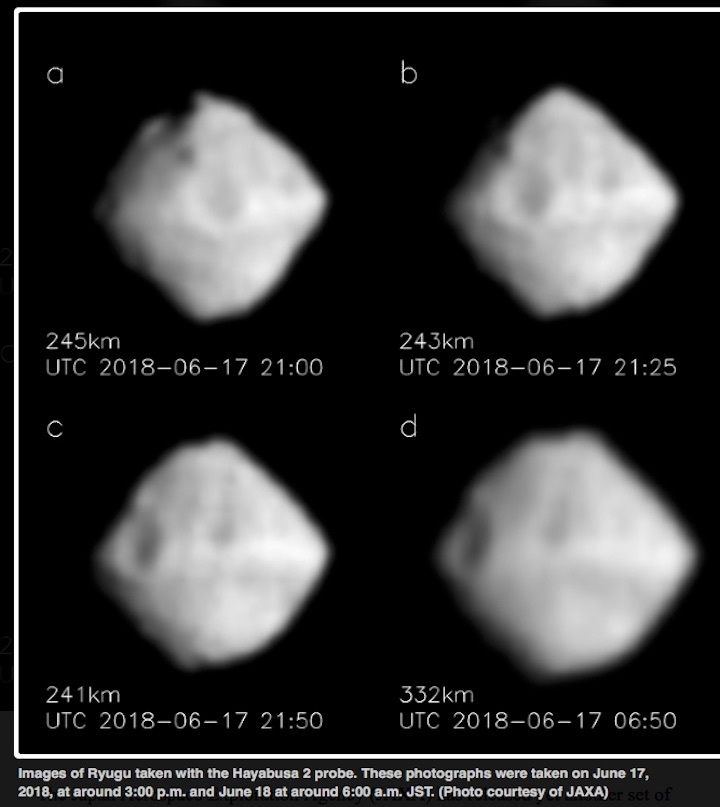
Images of Ryugu taken with the Hayabusa 2 probe. These photographs were taken on June 17, 2018, at around 3:00 p.m. and June 18 at around 6:00 a.m. JST. (Photo courtesy of JAXA)
The Japan Aerospace Exploration Agency (JAXA) has released yet another set of photographs of asteroid Ryugu taken by its Hayabusa 2 explorer from about 240 to 330 kilometers away from the object.
The images, taken from June 17 through June 18, show the asteroid in more detail than the ones taken about four to five days ago. It appears like a "spinning top," JAXA said, with crater-like dimples on the surface.
According to Hayabusa 2 project scientist Seiichiro Watanabe, this form is seen in many small asteroids that are rotating at high speed, and resembles the shape of the asteroid Bennu, which is the target of a NASA exploration project using the OSIRIS-REx probe.
Ryugu is now estimated to be about 900 kilometers in diameter and rotates about every 7 1/2 hours.
The Hayabusa 2 explorer is expected to reach a point about 20 kilometers from Ryugu on June 27. It is scheduled to make three landings on the asteroid to collect samples starting in November, and return to Earth around the end of 2020.
Quelle: The Mainichi
+++
About Asteroid Explorer "Hayabusa2"

Hayabusa2 to clarify the origin and evolution of the solar system as well as life matter
Asteroid Explorer “Hayabusa2” is a successor of “Hayabusa” (MUSES-C), which revealed several new technologies and returned to Earth in June 2010.
While establishing a new navigation method using ion engines, Hayabusa brought back samples from the asteroid “Itokawa” to help elucidate the origin of the solar system. Hayabusa2 will target a C-type asteroid “Ryugu” to study the origin and evolution of the solar system as well as materials for life by leveraging the experience acquired from the Hayabusa mission.
To learn more about the origin and evolution of the solar system, it is important to investigate typical types of asteroids, namely S-, C-, and D-type asteroids. A C-type asteroid, which is a target of Hayabusa2, is a more primordial body than Itokawa, which is an S-type asteroid, and is considered to contain more organic or hydrated minerals -- although both S- and C- types have lithologic characteristics. Minerals and seawater which form the Earth as well as materials for life are believed to be strongly connected in the primitive solar nebula in the early solar system, thus we expect to clarify the origin of life by analyzing samples acquired from a primordial celestial body such as a C-type asteroid to study organic matter and water in the solar system and how they coexist while affecting each other.
+++
TopicsRyugu seen from 330-240km
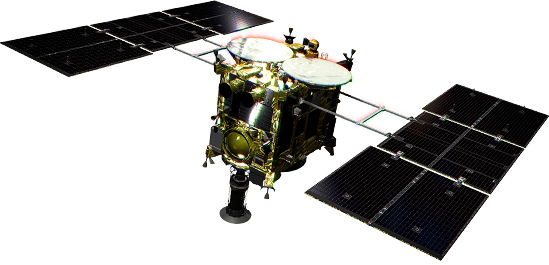
The ONC-T (Optical Navigation Camera - Telescopic) captured images of Ryugu on June 17, 2018 at around 15:00 JST and June 18 at around 06:00 JST. At 15:00 JST on June 17, the distance to Ryugu was approximately 330 km, which had decreased to 240 km by June 18 at 06:00 JST.
The following figures show the original images taken by the ONC-T, without any pixel smoothing. The order of the photographs is not chronological, but show the sequential rotation of the asteroid. The change in distance is compensated by keeping the size of the asteroid constant through the image set.
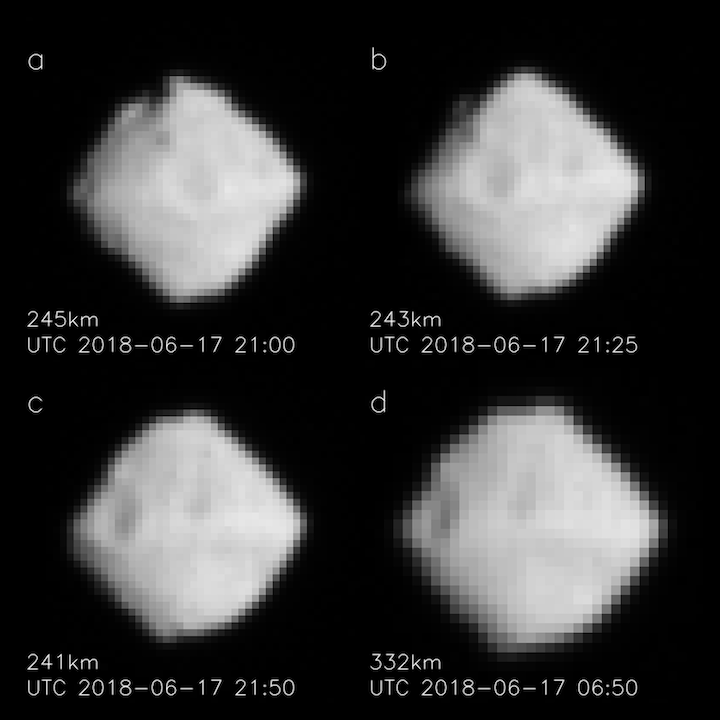
[Enlargement]Figure 1: Images of Ryugu taken with the ONC-T. These photographs were taken on June 17, 2018 at around 15:00 and June 18 at around 06:00 JST. They are arranged in order of rotation; a, b, c, d.
ONC team: JAXA, University of Tokyo, Koichi University, Rikkyo University, Nagoya University, Chiba Institute of Technology, Meiji University, University of Aizu and AIST.
This next image set is the same as the previous photographs, but with the pixels smoothed and the image processing applied which emphasizes light and dark regions.
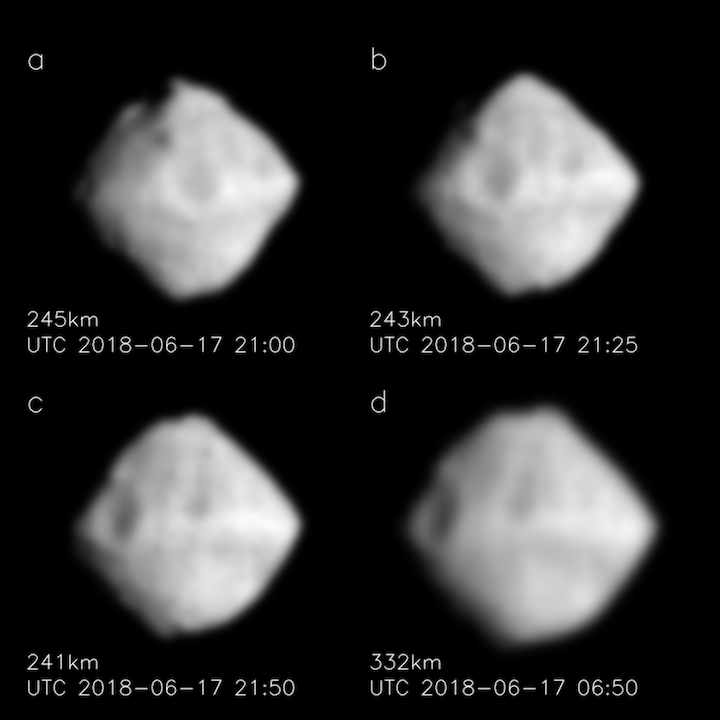
[Enlargement]Figure 2: Images of Ryugu taken with the ONC-T. Image interpolation was performed during enlargement and the light and dark regions emphasized (brightness squared). The photographs were taken on June 17, 2018 at around 15:00 JST and June 18 at around 06:00 JST. They are arranged in order of rotation: a, b, c, d.
ONC team: JAXA, University of Tokyo, Koichi University, Rikkyo University, Nagoya University, Chiba Institute of Technology, Meiji University, University of Aizu and AIST.
Comment by Project Scientist, Sei-ichiro Watanbe
The vertical direction in these images is tilted by 10 degrees counterclockwise compared to the vertical direction of the orbital plane of Ryugu. From looking between the multiple images in this set, you can see that the vertical direction is nearly perpendicular to the plane of revolution of the asteroid. We call this direction the asteroid's axis of rotation. The direction of the rotation is reversed compared to the Earth, with a rotation period of about 7.5 hours.
The diameter of Ryugu is about 900m, which is consistent with the prediction from ground observations. However, since the distance between the spacecraft and Ryugu is not precisely determined, there is still some uncertainty in the exact diameter at this time.
The shape of the asteroid looks like a spinning top (called a "Coma" in Japanese), with the equatorial part wider than the poles. This form is seen in many small asteroids that are rotating at high speed. Observed by radar from the ground, asteroid Bennu (the destination of the US mission, OSIRIS-REx), asteroid Didymous (the target of the US DART project), and asteroid 2008 EV5 that is approaching the Earth, all have a similar shape.
On the surface of asteroid Ryugu, you can see a number of crater-like round recessed landforms. In the first image, one large example can be seen with a diameter exceeding 200m. This moves to the left and darkens as the asteroid rotates and the lower part becomes cast in shadows.
The bulge at the equator forms a ridge around the asteroid like a mountain range. Outside this, the surface topology appears very ridge-shaped and rock-like bulges are also seen. These details should become clearer as the resolution increases in the future.
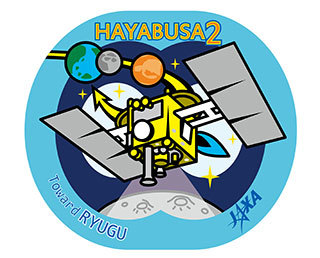
Comment by Mission Manager, Makoto Yoshikawa
When I saw these images, I was surprised that Ryugu is very similar in shape to both the destination of the US OSIRIS-REx mission, asteroid Bennu, and also the target of the previously proposed MarcoPolo-R mission by Europe, asteroid 2008 EV5. Bennu and 2008 EV5 are about half the diameter (and 1/8 the volume) of Ryugu, with rotation periods about half as long. In other words, these celestial bodies are small and rotating fast compared to Ryugu. On the other hand, Bennu is a B-type asteroid, which is very similar to C-type asteroids such as 2009 EV5 and Ryugu. Therefore there should also be common properties due to the asteroid type. So we have both differences and similarities that have combined to produce very similar shapes... why is that? I think this is very interesting. So far, the asteroids we have explored have been different in shape, so Ryugu and Bennu could be the first time two similar-shaped asteroids have been examined. It will be interesting to clarify exactly what this similarity means scientifically.
If the axis of rotation for Ryugu is close to the vertical direction in this image, there is a big advantage as it will be possible to know almost the entire appearance of Ryugu at an early stage after arrival. This makes the project planning easier. However, it is also possible that potential landing sites may be limited to the equator of Ryugu. I hope we can find a suitable place to set down the lander and rovers.
Quelle: JAXA
---
Update: 22.06.2018
.
Ryugu seen from 330-240km
The following figures show the original images taken by the ONC-T, without any pixel smoothing. The order of the photographs is not chronological, but show the sequential rotation of the asteroid. The change in distance is compensated by keeping the size of the asteroid constant through the image set.
